
|
||
|
Portland art blog + news + exhibition reviews + galleries + contemporary northwest art
|
||
Populist Visionaries: Finster and Abernathy This February two solo shows in Portland seem to capture the current zeitgeist of the city and beyond. The micro survey of folk art icon Howard Finster, Space Is My Future at the Portland Museum of Modern Art and Tori Abernathy's Make Yourself at Home at HQ Objective both offer themselves as generous hosts with wildly divergent evangelistic/activist zeal that question the status quo. Though completely different these two exhibitions are tempered with a well-intentioned goal of sharing information for the improvement of the human race, something rarely seen in art exhibitions, which tend to be more abstruse in their aims.
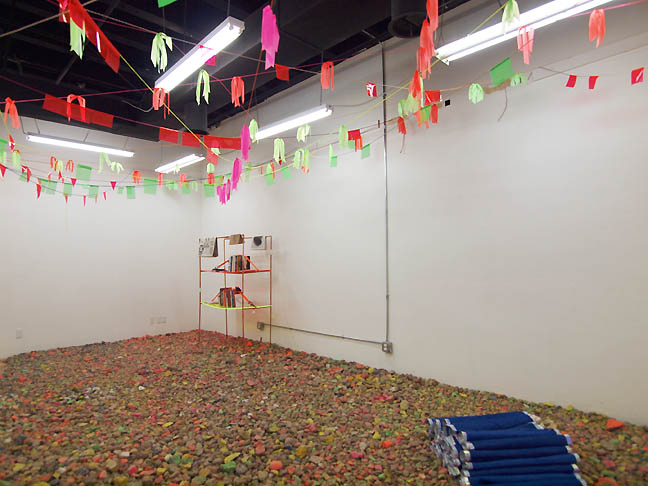 Tori Abernathy's Make Yourself at home at HQ projects (all photos Jeff Jahn) Abernathy's installation recalls Walter De Maria's Earth Room filled with gravel and concrete that has been sprayed with neon spray paint used on construction sites. Her installation also sports an intentionally flimsy copper tubing supported shelf. The Plexiglas shelves themselves are groaning under the weight of the resource books, which is in keeping with the topic of addressing the crushing weight that debt for most Americans are struggling against. There are streamers and yoga mats that look like they are from vintage 70's sci fi program... its a kind of back to the future party using construction site visual cues. The Reed educated Abernathy, is one of the brightest minds in Portland and Ive liked every exhibition with her name on it,but because she writes for PORT I was waiting for something with irresistible force. This show has it, though debt seems to be the immovable object. 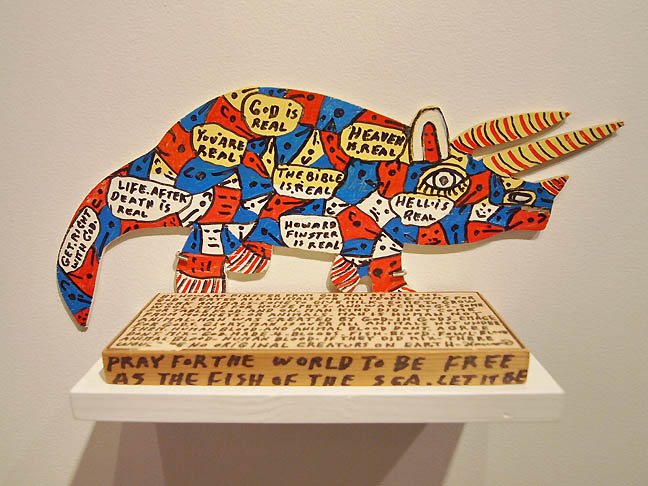 Howard Finster Rhino (1990) at PMOMA, Collection of Shari Hood In contrast Finster (1916-2001) was a Baptist minister who according to lore was told by God in a vision to paint 5,000 paintings to spread the gospel. He achieved his goal and is considered one of the most important "outsider artists" alongside Henry Darger, Bill Traylor, Mr. Imagination and Eugene Von Bruenchenhein. You dont see much of this type of work on the West Coast but in the Midwest and South it is everywhere including major museums. The term "outsider artist" is very problematic and somewhat artificial as everyone from George Orr, Van Gogh to Jean Dubuffet fits the definitions and it has clearly influenced artists like Chris Johanson, Kara Walker and even Paintallica. The term gets even hairier as the pejorative "MFA Outsider art"... i.e. artists with advanced degrees using cheap or unsophisticated materials/methods are incredibly common as well. But Finster is the real deal, though there are a lot of fakes out there. For example his Rhino is a actually a triceratops proclaiming that, "Heaven is real," is a cut out form he often used and can be easily duplicated. On the base of that work is a rambling screed about man and animals not being the same thing and a discussion of blood and milk... the argument doesnt hold up but that isnt the point. It is his willingness to present an alternative worldview with such force. When I look at a Finster it I invariably seized with the thought, "hey man whatever floats your boat!" Though crude, Finster provokes a very cosmopolitan live and let live response. It is this sophisticated response to down home and idiomatic content that is "Very Portland" these days. 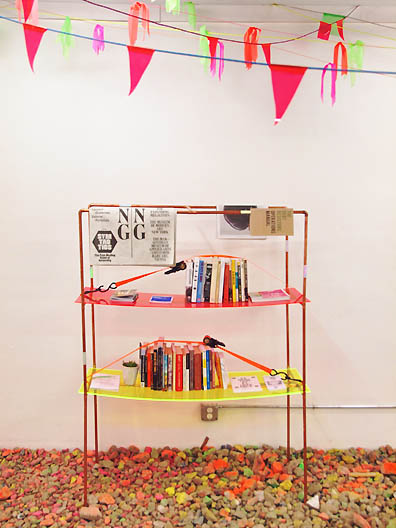 Tori Abernathy The important thing here is the way both Abernathy and Finster's exhibitions exist as a kinds of Folk art or "revival" uprisings... ie for the people and it is interesting how two such wildly different personalities approach it (yes Contemporary Art can be for the folk). I enjoy the optimism of both. Finster is fanciful religious evangelist (though Im not sure he saw himself that way), whereas Abernathy is a pragmatic activist drawing on her own life experience and zeitgeist as Portland rents have risen lately (though still far less than San Francisco, Seattle and Los Angeles). Though inexpensive by West Coast standards Portland recently ranked as the #5 fastest rent cost city in the country so Abernathy is incredibly topical. Finster is a folk art icon who has influenced contemporary artists like Chris Johanson and the collective Paintallica (Johanson is more secular/poetic and Paintallica is far more adolescent/id obsessed but the strategies are similar). 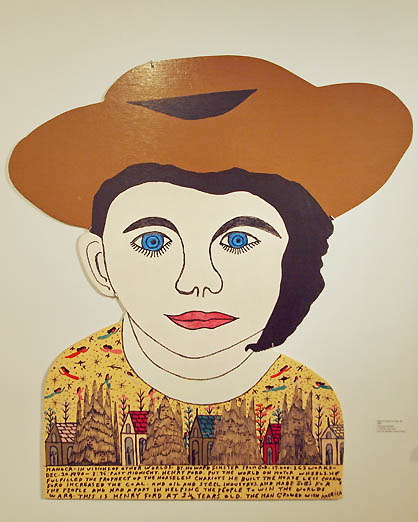 Howard Finster, Henry ford at 2 1/2 (1990) Collection of Sheri Hood A commentary on commerce plays a part in both artists' work. In Finster's utopian/populist vision a depiction of a 2.5 year old Henry Ford fulfills a prophecy by making the horseless carriage available to all and creating jobs in America that allowed the Allies to win WWI and II. That may be true but Finster must have understood how Ford lost more than some of his innocence in the process of becoming an icon of industry or he wouldnt have portrayed him at such a tender age? Lately, there has been blow back against the industrial revolution and many in Portland (and elsewhere) attempt to source products as close to home as possible. Regardless, Finster reminds us of the optimism in the American Dream. 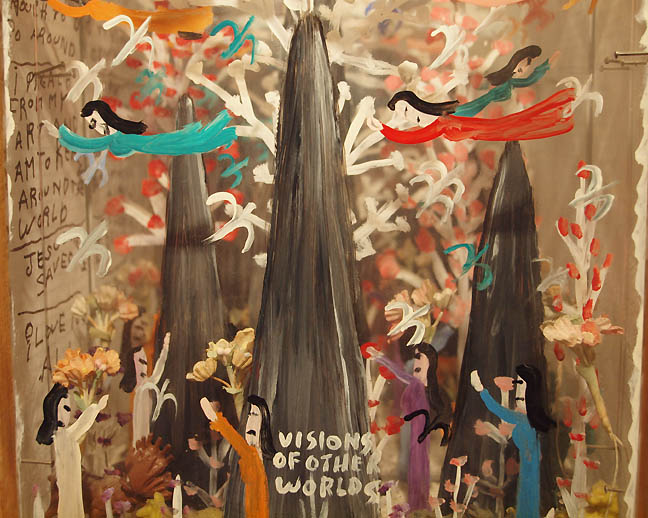 Howard Finster, Landscape with Jewls (detail) 1986 Collection of Peter Buck In another work, Landscape with Jewls, Finster extols how his art preaches to the world while angels pen the message to the walls of the piece. There is an overall innocence and pressing need to present it as a hopeful vision. In a cynical world, where the art market seems to swallow everything this is heartening and the spirit of it all doesnt seem that far off from Abernathy's, whose work her takes materials and vernacular from a very macho construction sites to create a community meeting place. Instead of a pure exhibit her Make Yourself at Home is more like a happening Like Gordon Matta-Clark's Food or Franz West's Chou-Chou or Rirkrit Tiravanija's Social Pudding. The work exists as a stage for things to happen and in particular she is staging the First Portland's Renters Assembly daily from February 24-26, from 7-10PM in the space. You should go but it works as an exhibition too, though "shelf art" has been used too much, this works. Also, I like how these types of shows act as a kind of archeological site where the artist excavates the present tensions of the age even when you are the only person in the room. 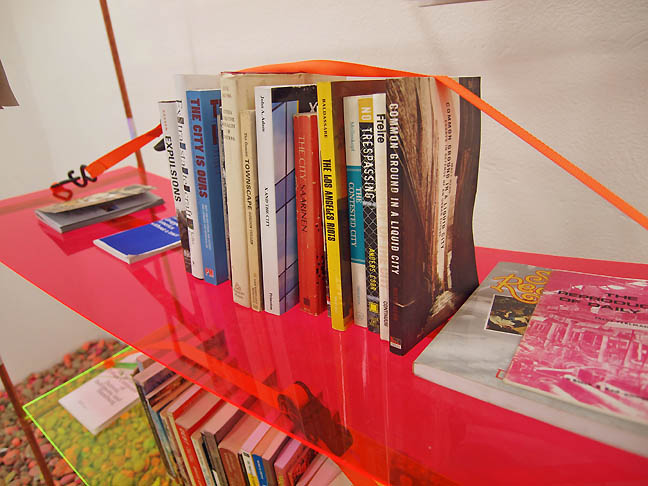
Tori Abernathy (shelf detail) In particular it is the book shelves that are most loaded in Abernathy's show. For example; Saskia Sassen's Expulsions, Jane Jacobs' Cities and the Wealth of Nations, The City Is Ours: Squatting and Autonomous Movements in Europe from the 1970s to the Present and The Debt Resistor's Operations Manual pamphlet present a prepared awareness. The sense is that the people Abernathy has reached out to are armed to resist what Sassen terms the, "Savage Sorting" and "Predatory Formations" in an interconnected a global economic system where the "Financialization of Everything" allows everyone but the 1% to be squeezed. No, Sassen isn't some crackpot as her work is backed by intense mathematical models that allow desperate events to coordinate into, "Predatory Formations." These are the same kinds of high order mathematical models that are used by hedge fund managers. For Finster there is resistance with a promise of heaven and for Abernathy there is resistance to a market that just isnt working for so many with the promise that somehow that activity can turn the tide for the 99%. Occupy wasn't the first push back and Abenathy's Make Yourself At Home wont be the last art project to address these issues but sometimes art is as Joesph Beuys put it, "Social Sculpture." What both Finster and Abernathy present is a more intense vision and it is the sort of message that Portlander's respect even though they couldn't be more different. Resisting debt and resisting the devil indeed... Make Yourself At Home runs through March 1 at HQ Objective, 232 SE Oak #108 Posted by Jeff Jahn on February 26, 2015 at 13:11 | Comments (0) Comments Post a comment Thanks for signing in, . Now you can comment. (sign out)
(If you haven't left a comment here before, you may need to be approved by
the site owner before your comment will appear. Until then, it won't appear
on the entry. Thanks for waiting.)
|
| s p o n s o r s |
 |
 |
 |
 |
 |
 |
 |
 |
 |
 |
 |
 |
 |
 |
 |
 |

|
Site Design: Jennifer Armbrust | • | Site Development: Philippe Blanc & Katherine Bovee | |

